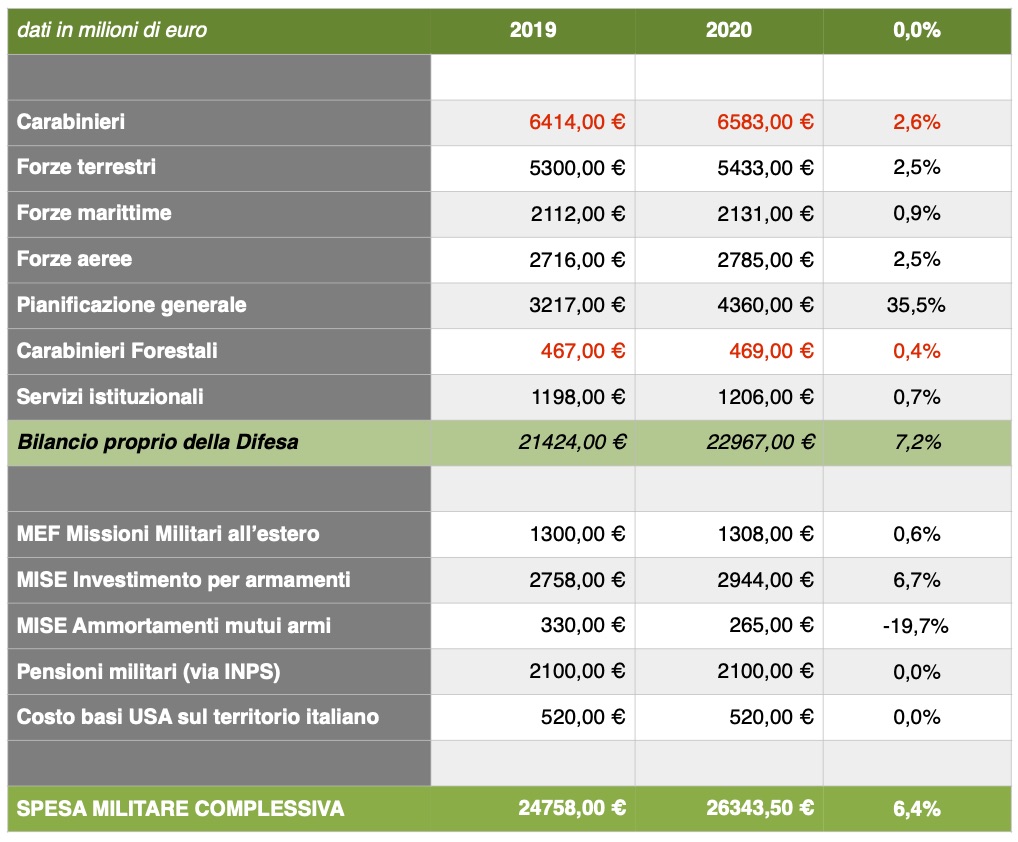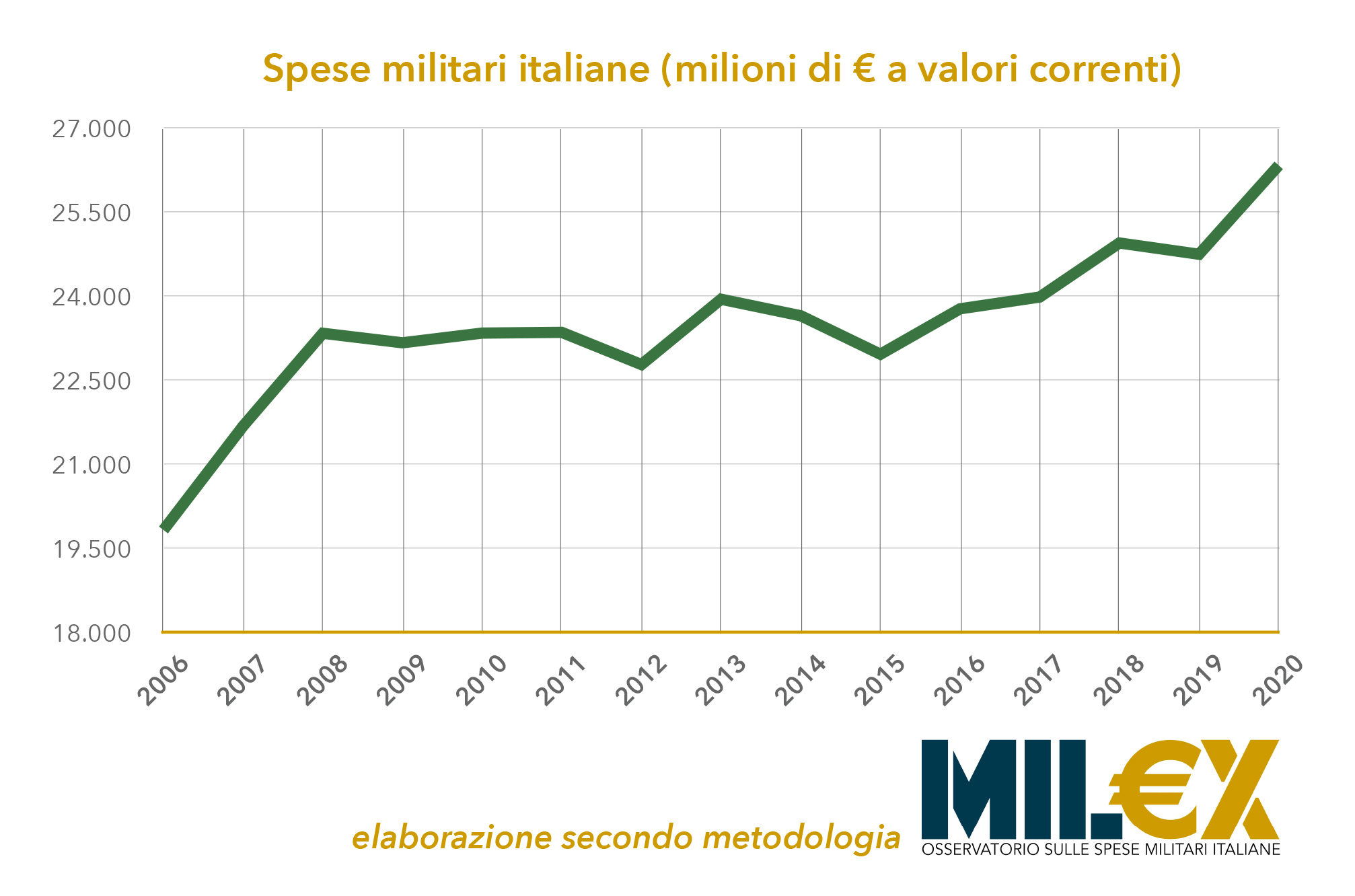The increase is 6.4% with a raise of more than 1.5 billion euros compared to 2019.
Methodological note
This sheet elaborated by the Mil€x Observatory on Italian military expenditure aims to provide the most precise and in-depth assessment possible of the Italian State’s military investments in 2020 with the documentation currently available.
A methodological premise concerning military expenditure in general and those relating to Italy in particular is required. Assessing military expenditure in a complete manner is an arduous task, because while some costs are obviously of this nature for others it is more difficult to establish precisely what kind of function they have within the state apparatus.
As a scientific reference criterion, the Mil€x Observatory uses as a standard the definition of military expenditure of the SIPRI research institute in Stockholm, which is globally considered among the most reliable and rigorous, yet it should be noted that despite this convergence the estimates regarding Italy may also be strongly different. This is because, on the one hand, SIPRI normally considers final estimates, while the specific sheet you have in your hands focuses on the budget forecast, and on the other because there is obviously a different degree of access to official documents and figures from the State Budget. In this sense, the Mil€x estimate can be considered more reliable and precise because for us it is easier and more direct to access documents even in the original language without the need for mediation by the departments and public offices in charge.
Moreover, the Mil€x Observatory has not only developed in recent years a capacity for direct and reliable analysis of the documentation of the Budget Law, but it has also been able to develop some mechanisms to evaluate parts of military expenditure that can be deduced only indirectly (pension costs, presence of foreign bases on Italian territory, etc.).
The last important point before moving on to the analysis of the data is the already mentioned predictive nature of this estimate, as it is based on the documentation of the Budget Law voted by Parliament at the end of 2019 and whose chapters and allocations could therefore be subject to changes by the Government during the year. This means that the real military expenditure in 2020 may, in the end, also differ greatly from the estimates provided in this document, and indeed this is usually what happens: almost always there are higher final figures than the budgets forecast. This would seem to take values away from the data provided here, which, on the contrary, have an interest and relevance that are in no way affected by the considerations that have just been made. This is because one of the most important aspects of the analyses that are conducted on military spending is also the trend dynamics, because it is able to provide indications on the political choices of the various governments on the subject, recalling clear comparisons between various budgets. We therefore believe it is appropriate to continue to provide an in-depth assessment of forecast military expenditure, with a consolidated methodology that makes it directly and fully comparable with that of previous years.
The estimate of Italian military expenditure for 2020
We would like to remind you that the counting methodology elaborated by the Mil€x Observatory and deriving from the already mentioned SIPRI definition of military expenditure provides that military chapters present in other Ministries should also be added to the Ministry of Defence’s own budget, as well as subtracting (totally or partially) costs falling within the same Department but evidently with non-military functions.
The table below provides a comparison between the forecasts for 2019 and 2020 of the expenditure items selected according to the above criteria. Figures that are not included (in whole or in part) in the Mil€x estimate are shown in red.

As can be clearly seen, the military expenditure forecast for 2020 shows a very strong increase of more than 1.5 billion euros, equal to more than 6% more on an annual basis, both for the direct growth of the budget of the Ministry of Defence and for the maintenance of high levels of expenditure of a military nature also on other Departments. The share of investment for new weapons systems coming from the Ministry of Economic Development (now almost three billion) continues to grow, but it is above all the decisive rise in investment for weapons allocated to the Defence budget (about 2.8 billion with a +40% increase compared to 2019) that brings the funds available for the purchase of new weapons to a perhaps record level of almost 6 billion.
It is important to note that due to a lack of documentation and reliable details on pension transfers at the moment and the difficulty inherent in the elaboration of estimates on the specific item related to the international bases present in the Italian territory, these specific figures have been considered unchanged compared to the previous year. A choice of approximation which in any case allows for an overall realistic estimate and does not distort the comparison of trends between one year and the next since these items are not subject to sudden changes as they are medium-long term choices and consequences.
On the other hand, the impact on this year and on a multi-year level of some investment programmes for weapons systems announced in recent years, within larger funds prepared by the Presidency of the Council of Ministers or funds agreed between the Ministry of Defence and the Ministry of Economic Development, have yet to be defined, and therefore have not been considered in this in-depth report. We would like to refer to subsequent sheets and analyses for an in-depth evaluation of these specific aspects.
Finally, as a track of work and confirmation of the already highlighted tendency to have a final expenditure much higher than the budget forecast, it is worth noting that the official documentation of the Budget Law notes on this financial year the presence of presumed residues for the Ministry of Defence amounting to 1,007 million euros. Which then involve cash authorizations for 23,296 million and a total expendable amount (residual plus accrual) for 2020 of 23,977 million. That is, about one billion round more than what is shown in the above forecasts (but which cannot be attributed “in full” to military expenditure because it could concern residues relating, for example, to the police and territorial control functions of the Carabinieri).

